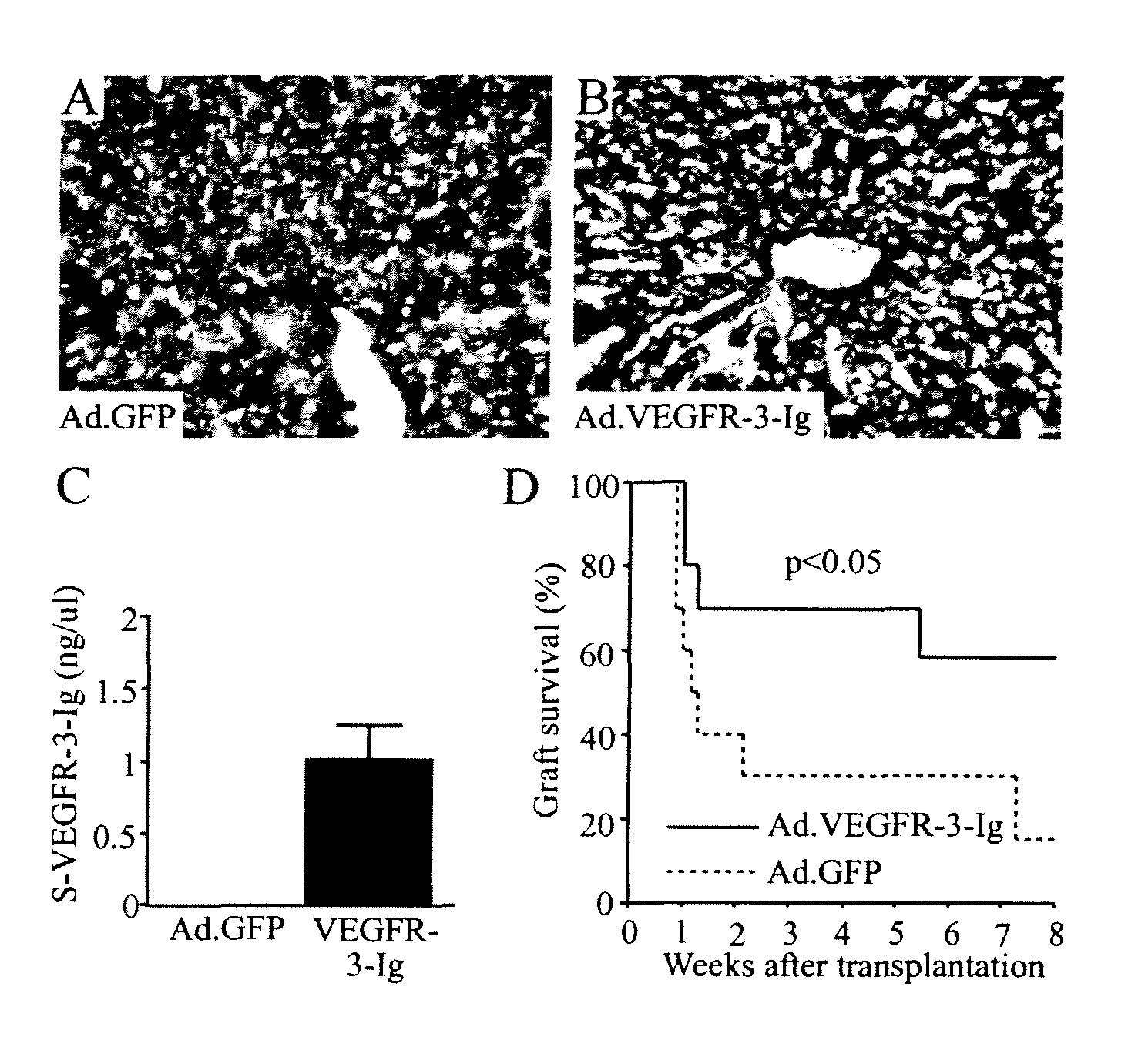Growth factor antagonists for organ transplant alloimmunity and arteriosclerosis
a growth factor antagonist and organ transplant technology, applied in the direction of immunological disorders, antibody medical ingredients, peptide/protein ingredients, etc., can solve the problems of several metabolic, infectious, renal and malignant side effects, and the adverse effects of alloimmune responses on cardiac allografts and heart transplant recipients, so as to reduce or ameliorate an immune reaction, improve the outcome of transplant recipients, and reduce or ameliorate arteriosclerosis
- Summary
- Abstract
- Description
- Claims
- Application Information
AI Technical Summary
Benefits of technology
Problems solved by technology
Method used
Image
Examples
example 1
VEGFR-2 and VEGFR-3 Fragments that Bind VEGF-A or VEGF-C
[0376]To determine the portion of a receptor's extracellular domain (ECD) that was sufficient for ligand binding, fragments of the ECDs of VEGFR-2 (R-2) and VEGFR-3 (R-3) were used to make various soluble constructs. The constructs included Fc domain human IgG fragments fused to the C-terminus of the receptor fragments. As indicated in Tables 3 and 4, some constructs were made using a heterologous (N-terminal) signal peptide derived from CD33.
[0377]Construction of Fragments and Plasmids
[0378]R-2 Constructs
[0379]To construct the VEGFR-2 / IgG expression plasmid, the construct, R-2 A, comprising the first three Ig-domains (D1-3) of VEGFR-2 was amplified by PCR using primers 5′-GCGGATCCTTGCCTAGTGTTTCTCTTGATC-3′ (SEQ ID NO: 72), and 5′-CCAGTCACCTGCTCCGGATCTTCATGGACCCTGACAAATG-3′ (SEQ ID NO: 73), and cloned into the Signal pIgplus vector (Novagen, Madison, Wis.). The resulting plasmid was digested with BamHI and KpnI, treated with T4 ...
example 2
Ligand Binding Assays Involving Binding Constructs with More than One Binding Element
[0398]The assays as performed in Example 1 are repeated, substituting a binding construct with multiple binding units. For example, one employs a binding construct comprising a binding unit that binds VEGF-A and a binding unit that binds VEGF-C. One looks for the ability of such a binding construct to bind both VEGF-A and VEGF-C. This information may be obtained by using different radio- or other labels, e.g., fluorescent labels for fluorescence resonance energy transfer (FRET), on each type of ligand or use of labels on the binding construct and or ligands, to determine whether a given binding construct molecules are binding a molecule of VEGF-A and VEGF-C. Constructs that are shown to bind more than one growth factor ligand, as well as those described in Example 1 and elsewhere herein, have an indication for anti-neoplastic therapies where multiple growth factors contribute to neoplastic cell grow...
example 3
Chimeric VEGFR Binding Constructs which Bind Multiple Ligands
[0399]As stated above, constructs that bind more than one growth factor ligand have an indication as anti-neoplastic therapies where multiple growth factors contribute to neoplastic cell growth. In order to determine the efficacy of a binding construct designed to bind more than one growth factor, two chimeric binding constructs were generated and their ability of each to bind to two growth factors was measured.
[0400]The binding constructs were designed as immunoblobulin fusion proteins as described above. To construct chimeric VEGF receptor / hIgG1Fc fusion proteins, the pIgPlus vector was used to build a construct comprising the first immunoglobulin-like domain of VEGFR-3 and the second and third Ig-like domains of VEGFR-2. The construct is designated R-3D1-R2D2+3 / hIgG1Fc. To clone the R-3D1-R2D2+3 / hIgG1Fc construct, PCR was performed with CMV forward primer (18782, 5′TACTTGGCAGTACATCTACGTATTAGTCATCGC-3′) (SEQ ID NO: 122) ...
PUM
| Property | Measurement | Unit |
|---|---|---|
| composition | aaaaa | aaaaa |
Abstract
Description
Claims
Application Information
 Login to View More
Login to View More - R&D
- Intellectual Property
- Life Sciences
- Materials
- Tech Scout
- Unparalleled Data Quality
- Higher Quality Content
- 60% Fewer Hallucinations
Browse by: Latest US Patents, China's latest patents, Technical Efficacy Thesaurus, Application Domain, Technology Topic, Popular Technical Reports.
© 2025 PatSnap. All rights reserved.Legal|Privacy policy|Modern Slavery Act Transparency Statement|Sitemap|About US| Contact US: help@patsnap.com



